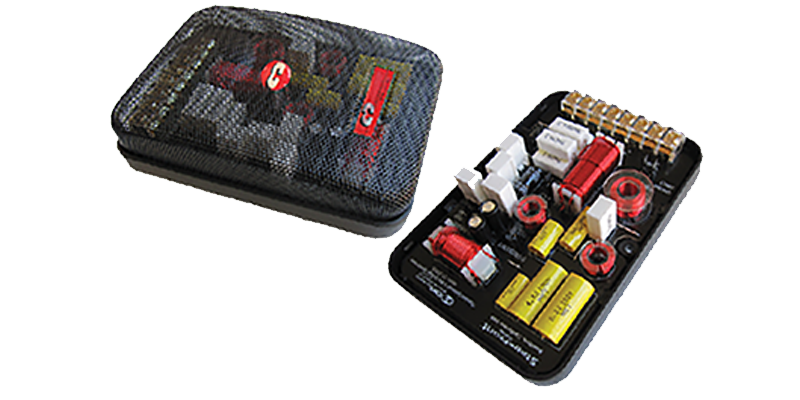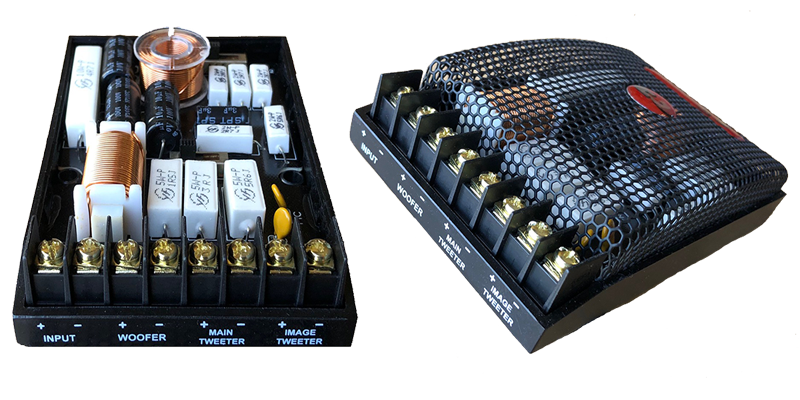

The elliptic differs from the others mentioned in having "zeros" in the stop band. This means the roll off shifts between two rates and can even result, if the parameters are so adjusted, to show increases in drive in the stop band. Since most drivers would sound excellent with no crossover at all but would burn out and overload almost immediately, crossovers are necessary to prevent low frequencies which are beyond a midrange or Tweeters capability from entering them.

It is also then necessary to use many drivers to cover the frequency range to enable frequency and load sharing and power handling. Some cone type drivers can achieve nearly full range and play adequately loud in car and home environments. Generally some bass and highs must be sacrificed. This type is found in many OEM cars due to low cost and compact installation. The Butterworth and Linkwitz-Riley (L-R) differ not in configuration but in the setting of the values and order of the sections. The Butterworth gives a flat response on axis but has a power response increase in the crossover region. The L-R damps the response somewhat more and decreases overlap to provide a compromise in power and frequency response. The L-R is actually a combination of two Butterworth sections. The drivers usually have to be inverted in phase relative to each other in the Butterworth and L-R. The overlap in the Butterworth can often also be reduced to provide good results especially in a reverberant environment such as found in the automotive sphere. Because the ear-brain can separate the sound of reverberation from the sound of ringing it makes an audible difference to provide crossover designs that give better transient response.
Transient respons degrades with greater order in practice. This audibly gives a system that has a character which remains embedded in the music over all musical sources. This character can overlay real information in the source thereby obscuring it. Usually the losses are barely noticeable up to an order of three. Beyond this the system can develop a character that is kind to various sources in that harshness is minimized but then information is lost when the very best recordings are used.
The louder the system will be run the more appropriate higher order designs become. The elliptic filter by allowing typically .1% to 1% of the input power to "bleed through" out of band gives faster roll off rates in the crossover region without degrading transient response. The gain is typically one to two orders of roll off added at no penalty. This gives a very clean sound and good power handling without overlaying the sound with excess character.The roll off of woofer power response is typically 24 db per octave and sometimes can reach 36 db or more if the driver is taken to the limit. This typically happens in most cases. The sound this makes is mitigated by the fact that part of the drop (12db/octave) is due to dispersion reduction.
The roll-off rate is actually staggered in the majority of cases. Metal cone drivers display somewhat different character, must be expertly employed and are an exception to this rule of thumb. Use of the elliptic in a fourth order configuration gives a transient response slightly better than a third order Butterworth and a roll-off rate slightly better than a fourth order of the same type. The same advantages apply to the L-R but in somewhat different proportions depending on the order.
Low passing woofers with high order filters to the Tweeter aggravates an already steep power response roll off in that driver by itself - an exception is in a pure woofer application where the crossover frequency is much lower than the natural cutoff of the driver.
The net crossover in the CDT system is designed to interface the mid woofer to the soft dome Tweeter to give optimum overall performance and consistent results. Only a loss in power handling and a custom in-car install and unusually delicate main drivers (not rugged miniature woofers) can provide a smoother more detailed easy listening experience. This can be accomplished with cone drivers that are both full range, crossed over to and interfacing with a Tweeter that uses its own mechanical properties to augment filter response. Every car requires different positions and settings and the settings are hyper critical. Although the networks are simple there are more of them.
